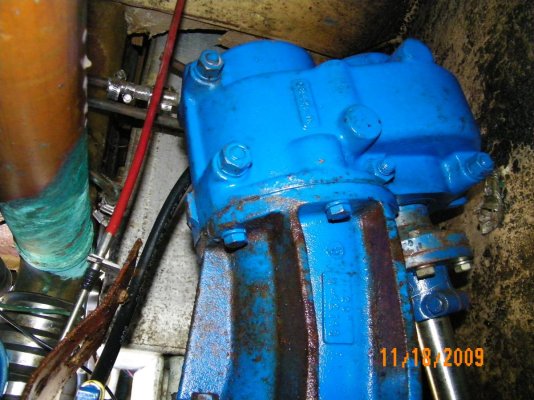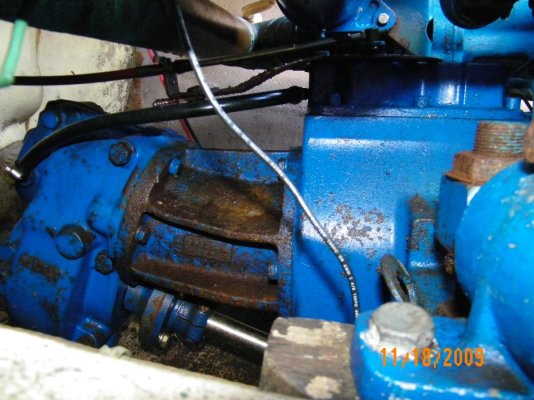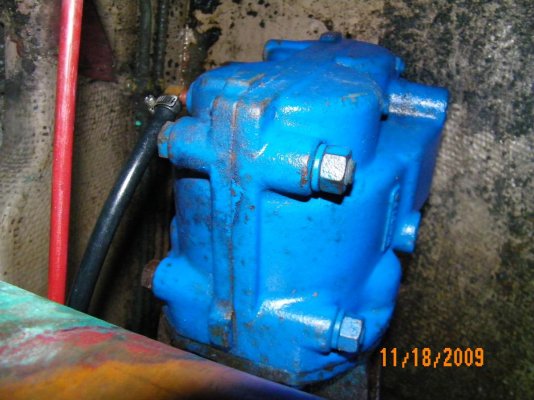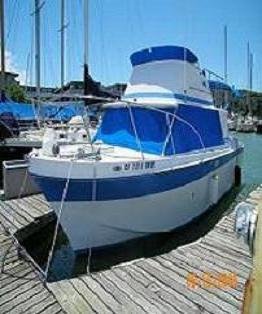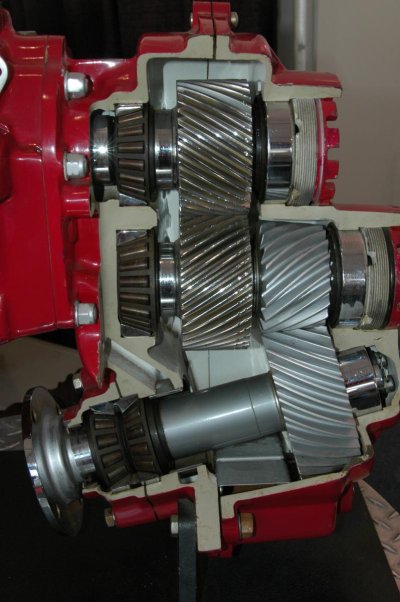You are using an out of date browser. It may not display this or other websites correctly.
You should upgrade or use an alternative browser.
You should upgrade or use an alternative browser.
V-Drives
- Thread starter kartracer
- Start date
The friendliest place on the web for anyone who enjoys boating.
If you have answers, please help by responding to the unanswered posts.
If you have answers, please help by responding to the unanswered posts.
O C Diver
Guru
- Joined
- Dec 16, 2010
- Messages
- 12,868
- Location
- USA
- Vessel Name
- Slow Hand
- Vessel Make
- Cherubini Independence 45
Can't answer the HP question, but stuffing boxes can be really challenging depending on configuration. The 2 units I helped a mechanic buddy of mine do a stuffing box repack and a shaft alignment on, were enough to convince me you couldn't give me a twin engine boat with them. Maybe a single engine boat would have more reasonable access.
Ted
Ted
Ken E.
Guru
- Joined
- Nov 12, 2016
- Messages
- 1,974
- Location
- United States
- Vessel Name
- Hatt Trick
- Vessel Make
- 45' Hatteras Convertible
There must be mechanical losses, bending the power delivery as v-drives do. The installations I've seen have had terrible access for maintenance, which would be a deal breaker for me.
sean9c
Guru
My v-drive is remote mounted about 5ft in front of the engine, engine is under the cockpit floor. V-drive allows the cabin sole to be lower so everything else can be also. Pluses and minuses to everything, you have to look at specifics.
caltexflanc
Guru
Don't see how it would rob power any more than the universal on your car does. Ot a pod drive or outdrive an outboard motor.
As Sean says, depends on the boat design and install. Somewhere around on another drive I have pics of a modern Hatteras 60MY with them. Plenty of serviceable access to whatever it is you want to be servicing.
As Sean says, depends on the boat design and install. Somewhere around on another drive I have pics of a modern Hatteras 60MY with them. Plenty of serviceable access to whatever it is you want to be servicing.
Ski in NC
Technical Guru
Vee drives have more gears and bearings in play, so there is more driveline losses. But maybe only 1% more than a regular gear. Not worth worrying about.
Some vee-drive boats are set up with really nice weight balance/cg, some are ass-heavy and miserable. Which it is depends more on the design and less on whether straight drive or vee.
Some vee-drive boats are set up with really nice weight balance/cg, some are ass-heavy and miserable. Which it is depends more on the design and less on whether straight drive or vee.
Kart, there probably is a loss but how in the heck would you measure the loss in a boat? I had v-drives in my last boat and there would have been no way to determine if there was a loss.
That's such a puny thing to be worried about on a boat, why worry?

That's such a puny thing to be worried about on a boat, why worry?
mike50
Veteran Member
- Joined
- Feb 28, 2016
- Messages
- 64
- Location
- USA
- Vessel Name
- Wandering Star
- Vessel Make
- Defever - 68' steel custom
Our boat has twin 671’s, 3:1 Allison gears, going through 3:1 casell V drives, swinging 40” 3 blade props. At 10 knots the 671’s are at 1200 rpms, the props at 200, so vibration is minimal. Access to shaft packing gland is ok, but the trade off is the engine room is beam to beam in the stern.
Pete Meisinger
Guru
- Joined
- Oct 7, 2012
- Messages
- 3,145
- Location
- USA
- Vessel Name
- Best Alternative
- Vessel Make
- 36 Albin Aft Cabin
For every 90 degree change in direction you loose 10% of your horsepower.
A "V" drive actually changes the direction by 180 degrees (or so) but the 10 percent power loss will be pretty accurate.
pete
A "V" drive actually changes the direction by 180 degrees (or so) but the 10 percent power loss will be pretty accurate.
pete
caltexflanc
Guru
For every 90 degree change in direction you loose 10% of your horsepower.
I'm curious where you got that figure and what the math is behind it.
LaBomba
Guru
- Joined
- Nov 18, 2012
- Messages
- 1,240
- Location
- Canada
- Vessel Name
- Looking Glass
- Vessel Make
- Carver 370 Voyager
We have several boats in our marina with V drives in boats under 40 ft and the access to some shaft glands is not just limited but in some cases near impossible to get to. Love having the engines at the back with large hatches and easy access but I wouldn't have V drives unless access to the shafts was clearly adequate. Most boats are way overpowered anyway so I would not even consider the losses of the drive and certainly not at trawler speed.
We had 31', 1973 Uniflite; twin 350 cid Chris Craft engines, V-Drive trany.
All was well for years. Difficult to get to if repairs/adjustments became required. Not easy for fluid check/replace/add.
All was well for years. Difficult to get to if repairs/adjustments became required. Not easy for fluid check/replace/add.
Attachments
Don't V-drives reduce the angle of the drive shaft/prop wrt the water thus increasing efficiency somewhat?
Far from it in Canoe Cove 41s and 42s. Shaft angles are pretty sharp.
Don't know about others.
However, the owner of a Conoe Cove 41, then a 42, my BIL, also a Mechanical Engineer, says that the engines are "out back, where they belong"
Last edited:
Don't V-drives reduce the angle of the drive shaft/prop wrt the water thus increasing efficiency somewhat?
IMO - The parallel angle of shaft to prop underneath hull, in comparison to plane of hull bottom, is primarily restricted by prop diameter and distance of shaft from engine to prop. In that, prop diameter needs room to fit below the hull without touching. To get shaft more in parallel with hull, and therefore have prop plane more in right angle to the bottom plane, indent in hull is required for prop blades to circulate into.
And, it appears to me that V-Drive would likely make prop in less right angle to bottom plane; due to shorter than normal shaft length from trany to prop.
DNT99611
Senior Member
mike50 do I understand you have marine transmissions driving V-drives? Do you do your reversing with the trans? And do the V-drives have to be mounted in a perfectly vertical position?
O C Diver
Guru
- Joined
- Dec 16, 2010
- Messages
- 12,868
- Location
- USA
- Vessel Name
- Slow Hand
- Vessel Make
- Cherubini Independence 45
Some V drive setups use a V gear box that is separate from the transmission. The heat generated in that box on a buddy of mine's boat was impressive. Can't remember if that box was water cooled or not. You loose power when you convert energy to heat. The boat was twin engine, and when the V gearbox failed, that was impressive also.
Ted
Ted
There are a lot of trade-offs in boat design.
Yes a V drive is more complicated and harder to service, but the advantage is that is gives a lot more more.
In the world of express cruisers, a good comparison would be the Tiara 3500 (straight) vs the Searay 360 Sundancer (V drives). The Sundancer has an additional mid-stateroom (conversation pit) which really opens up the interior of the boat. Another advantage is less noise when driving the boat as the engines are at the back and not closer to the helm.
Another example where V drives shine is with the Carver Mariner 36. 4 steps up to the bridge and 3 steps down to a very large, level cabin area:
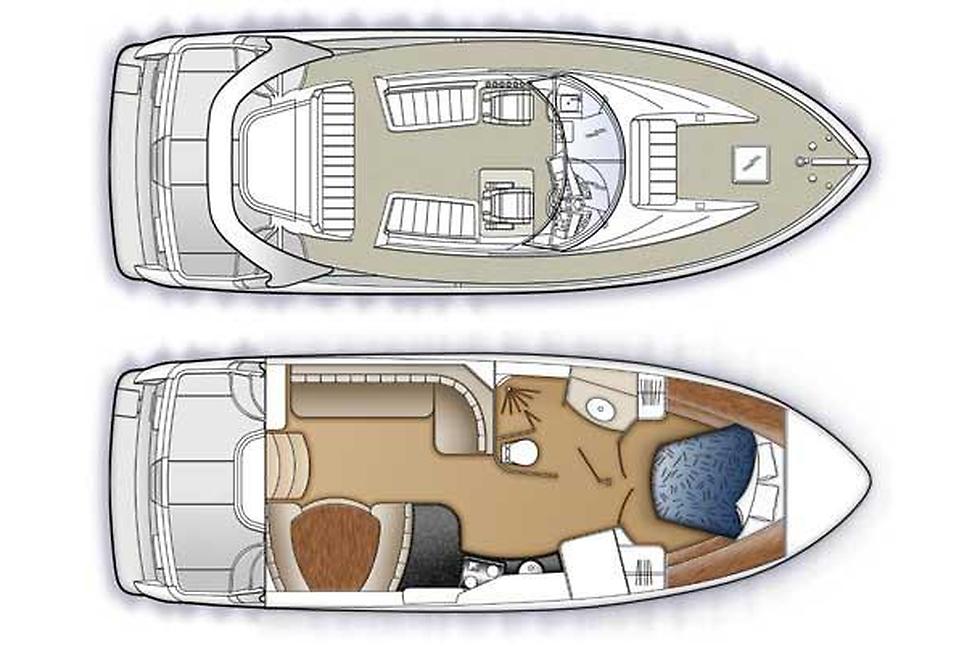
Jim
Yes a V drive is more complicated and harder to service, but the advantage is that is gives a lot more more.
In the world of express cruisers, a good comparison would be the Tiara 3500 (straight) vs the Searay 360 Sundancer (V drives). The Sundancer has an additional mid-stateroom (conversation pit) which really opens up the interior of the boat. Another advantage is less noise when driving the boat as the engines are at the back and not closer to the helm.
Another example where V drives shine is with the Carver Mariner 36. 4 steps up to the bridge and 3 steps down to a very large, level cabin area:

Jim
kartracer
Guru
- Joined
- Aug 5, 2014
- Messages
- 529
- Location
- USA
- Vessel Name
- M/V LUNASEA
- Vessel Make
- 45ft Bluewater Coastal
The boat I am asking about is a 41 Sundancer with diesels. JLD is right a lot more room with v drives. I am also wondering about bow rise and planning with all that weigh so far in the rear.
rslifkin
Guru
- Joined
- Aug 20, 2019
- Messages
- 7,584
- Location
- USA
- Vessel Name
- Hour Glass
- Vessel Make
- Chris Craft 381 Catalina
Assuming the boat is designed decently weight distribution wise, I'd expect engines aft with fuel tanks further forward might actually be better. In my case, my engines are a little aft of midships, fuel tanks are all the way aft (about where the engines would sit with v-drives). So there's a large change in weight distribution as fuel is burned, while having the engines and fuel tanks switched would make for much smaller changes (as the fuel weight is closer to the longitudinal CoG).
From a planing performance perspective, ideal weight distribution depends a lot on the hull and speed. On my boat, for example, around 17 - 18 kts (so this may change at higher speeds), the boat runs faster at a given throttle setting with weight moved further aft. Send a person from the bridge to the forward head and the boat will lose 0.1 - 0.2 kts no matter what you do with the trim. At high speeds this is likely less significant, but at lower speeds, weight further aft means more trim tab deployed to get the boat to the ideal running angle for best speed. And more tab out means more lift, so you end up increasing total lift and running with less hull in the water (which reduces drag more than the tabs add on my hull with pretty large 48x12 tabs).
From a planing performance perspective, ideal weight distribution depends a lot on the hull and speed. On my boat, for example, around 17 - 18 kts (so this may change at higher speeds), the boat runs faster at a given throttle setting with weight moved further aft. Send a person from the bridge to the forward head and the boat will lose 0.1 - 0.2 kts no matter what you do with the trim. At high speeds this is likely less significant, but at lower speeds, weight further aft means more trim tab deployed to get the boat to the ideal running angle for best speed. And more tab out means more lift, so you end up increasing total lift and running with less hull in the water (which reduces drag more than the tabs add on my hull with pretty large 48x12 tabs).
If you haven't yet joined ClubSearay, I would strongly encourage you to do so! 
It is a free and VERY active SeaRay forum. I have spent many hours just reading through several of the model specific sub-forums.
I think most folks love their Sundancers. I know that there are a couple of different models of the Sundancer that are on my possible boat list, depending on where my wife and I decide to retire in 2 - 3 years!
Jim
It is a free and VERY active SeaRay forum. I have spent many hours just reading through several of the model specific sub-forums.
I think most folks love their Sundancers. I know that there are a couple of different models of the Sundancer that are on my possible boat list, depending on where my wife and I decide to retire in 2 - 3 years!
Jim
sparky66
Veteran Member
For every 90 degree change in direction you loose 10% of your horsepower.
A "V" drive actually changes the direction by 180 degrees (or so) but the 10 percent power loss will be pretty accurate.
pete
Don't think so. The type of gearing used to change direction has a huge impact on efficiency. The change in direction in a v-drive is pretty small. Maybe 30 degrees?
garycasey
Veteran Member
The old rule of thumb for a spur gear mesh is that it robs 2% of the power per mesh. You have to compare how many meshes there are for each type of drive, so there isn't a fixed answer that covers them all. 2% isn't a big number, but if there are two extra meshes in the V-drive, that represents a 4% loss. not insignificant. But then there might be an improvement in prop angle relative the water flow. That could get 4% back.
Archhibb
Veteran Member
If access to the drives or something else like the stuffing boxes is terrible, none of the v-drives advantages are worth it to a conscientious boat owner. Otherwise, another plus to v-drives is the engines can be on very soft mounts because the v-drives transfer all the prop power to the hull. This, in conjunction with the engines aft location and short exhaust pipe runs, reduces noise and vibration significantly.
For every 90 degree change in direction you loose 10% of your horsepower.
A "V" drive actually changes the direction by 180 degrees (or so) but the 10 percent power loss will be pretty accurate.
pete
Hmmm ... sounds legit for 90 degrees.
But a V-Drive is more like 10 degrees.
It doesn't matter which side of the gear the shaft comes out.
A V-Drive gear has a slight bevel, whereas 90 degree gears are almost at 45 degrees.
Sorry, just an engineer's input
For a modest size trawler, I think that getting all tanks of fluids to the boat's CG would be better. So if pushing the engines back (behind the cabin) with a V-Drive will help that, it sounds good.
Also, if the V-Drive is separate from the engine mount (bell housing) so that the engine can be rotated, I think it would be very beneficial to put the drives closer to the center of the boat, so the props have better protection (ideally with a keel between to separate fluid flow) and tilt the drives outward, so that the input shaft is at an angle (viewed from the top) while the output shafts are parallel to the keel (again, viewed from the top). Such a tilt will move the engines further apart than the props, facilitating room for servicing. There is no negative impact on propulsion, because the prop doesn't know (or care) what's at the other end of the shaft.
If you combine this with a tunnel for the props, the tilt will place the engines beside (and higher than) the props in the tunnel, lowering the weight, and also lowering the floor-height above the engines.
Again, I'm not talking about laying the V-Drives on their sides. Just tilting them maybe 20 to 30 degrees off vertical, away from the center of the boat, to swing the engines out and away from each other, while moving the props closer to the center.
Have you seen this done?
Also, if the V-Drive is separate from the engine mount (bell housing) so that the engine can be rotated, I think it would be very beneficial to put the drives closer to the center of the boat, so the props have better protection (ideally with a keel between to separate fluid flow) and tilt the drives outward, so that the input shaft is at an angle (viewed from the top) while the output shafts are parallel to the keel (again, viewed from the top). Such a tilt will move the engines further apart than the props, facilitating room for servicing. There is no negative impact on propulsion, because the prop doesn't know (or care) what's at the other end of the shaft.
If you combine this with a tunnel for the props, the tilt will place the engines beside (and higher than) the props in the tunnel, lowering the weight, and also lowering the floor-height above the engines.
Again, I'm not talking about laying the V-Drives on their sides. Just tilting them maybe 20 to 30 degrees off vertical, away from the center of the boat, to swing the engines out and away from each other, while moving the props closer to the center.
Have you seen this done?
kapnd
Guru
- Joined
- Aug 31, 2013
- Messages
- 879
- Location
- usa
- Vessel Name
- #31
- Vessel Make
- ex-Navy MUB 50 fish/cruise
Installing vee drives is a decision driven by space and weight distribution factors.
The additional gear involved is insignificant in terms of power loss.
I’d recommend a remote vee drive, with an 18-24” driveshaft. That will put the flanges in easily accessible location for alignment, and the packing gland will be too.
It’ll also allow the shaft angle to be smaller, increasing propeller efficiency.
The additional gear involved is insignificant in terms of power loss.
I’d recommend a remote vee drive, with an 18-24” driveshaft. That will put the flanges in easily accessible location for alignment, and the packing gland will be too.
It’ll also allow the shaft angle to be smaller, increasing propeller efficiency.
I was told by several engineers that it doesn't really matter a lot in terms of power losses whether the "reversion" is handled within the gearbox itself or through a separate unit.Assuming it's integral with the marine gear
A solution that normally allows a better accessibility to the shaft seal, by the way.
Is your experience/knowledge different, in this respect?
Similar threads
- Replies
- 8
- Views
- 977
- Locked
- Replies
- 1
- Views
- 452

